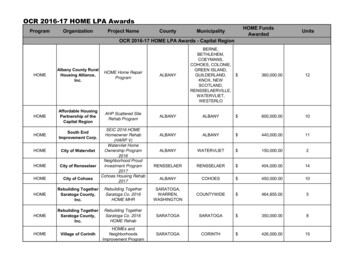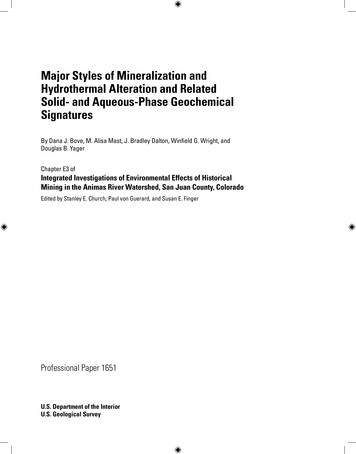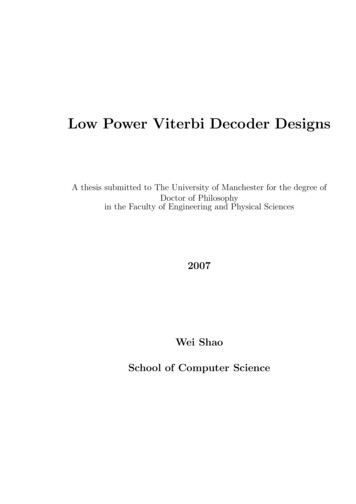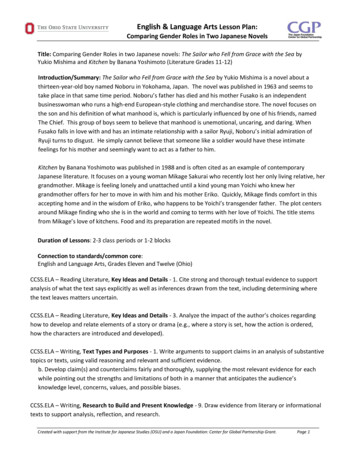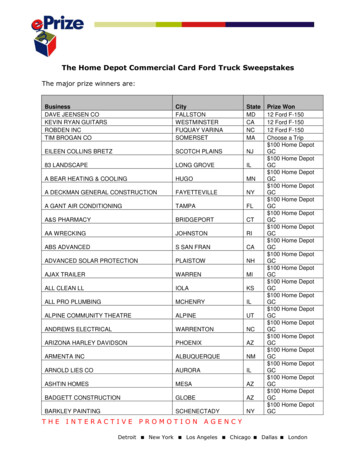
Transcription
Comparing the Performance of Home Affordable Modification Program(HAMP) Modifications and Non-HAMP Modifications: Early Results 1EXECUTIVE SUMMARYI.INTRODUCTIONSince the inception of the Making Home Affordable Program (MHA), more than 1.3 millionborrowers have had their mortgages permanently modified through MHA’s Home AffordableModification Program (HAMP). This paper analyzes the performance of HAMP modifications tobetter understand the key factors affecting their performance.In the first part of this paper, single-variable analysis and program-to-date data for all HAMPmodifications are used to identify correlations between various HAMP modificationcharacteristics and modification performance.The most significant factors driving HAMP modification performance are the amount of monthlypayment reduction relative to the borrower’s pre-modification payment, the length of theborrower’s delinquency at time of modification, and, to a slightly lesser extent, credit score attime of modification. Post-modification mark-to-market loan-to-value (MTMLTV) ratio appearsto have some influence on HAMP modification performance for certain segments of the HAMPpopulation. Other criteria, such as the borrower’s “back-end” debt-to-income (DTI) ratio2 andgeography have less influence on HAMP modification performance.In the second part, econometric analysis (regression testing) is used to isolate the key factorsaffecting HAMP modification performance and to compare the performance of loans modifiedthrough HAMP with other similarly delinquent loans. The innovation in this study comes fromthe merging of HAMP program data with a commercial loan performance database provided byCoreLogic,3 which allows HAMP-modified loans to be compared directly with two alternatecontrol groups consisting of loans that were modified outside of HAMP and loans that weresimilarly delinquent but never received a modification. The HAMP loans and the two controlgroups were restricted to loans that are part of private label mortgage-backed securities (PLS).The regression analysis generated the following results:Modified PLS loans – both HAMP and non-HAMP – perform significantly better than PLSloans receiving no modification.1This analysis described in this paper was performed by Walter Scott, a Fannie Mae economic researcher workingfor Fannie Mae in its role as program administrator for Making Home Affordable (MHA), a program of the UnitedStates Department of the Treasury and the Department of Housing and Urban Development. Unless otherwise noted,the data points, figures, and tables reflected herein were sourced from Treasury’s MHA system of record.2“Back-end” DTI refers to the borrower’s DTI taking into account all of the borrower’s monthly debt obligations,not just the obligations under the mortgage loan.3CoreLogic’s Loan Performance subprime database provides origination and performance history for approximately90 percent of all subprime and Alt-A residential mortgages that were bundled into private label mortgage-backedsecurities and active in the 2010-2011 timeframe.-1-
Payment reduction and delinquency at the start of the modification are initially the two mostsignificant factors driving the performance of both HAMP and non-HAMP modifications.However, the significance is found to be time sensitive: the importance of delinquency attime of modification decreases as the modification ages, while the importance of paymentreduction increases. Other factors contributing to performance include post-modificationMTMLTV, credit score at the time of loan origination, and geography.HAMP modifications of PLS loans perform better than non-HAMP modifications of PLSloans. This is true even when controlling for modification terms, including paymentreduction. For example, a HAMP modification of a PLS loan with a 10 to 20 percentpayment reduction performs better than a non-HAMP modification of a similar PLS loan alsowith a 10 to 20 percent payment reduction.The act of resetting a borrower’s delinquency level was proven to have a major initial impacton the borrower’s post-modification performance. This “delinquency reset effect” is alsotime sensitive and diminishes significantly as the modification ages.While confined to a subset of loans (i.e., PLS loans), these conclusions suggest that borrowers inHAMP modifications may be significantly less likely to experience redefault than borrowersreceiving no modification at all or a modification outside of HAMP. The importance of this issueto struggling borrowers, oversight bodies, lawmakers, and other housing policymakersunderscores the importance of further research on this topic and replication of this analysis on abroader set of loan data.II.SINGLE-VARIABLE ANALYSIS OF FACTORS DRIVING PERFORMANCEUSING DATA FOR ALL HAMP MODIFICATIONSAs of March 2014, over 945,000 permanent HAMP modifications were performing and in goodstanding within the MHA program. More than 380,000 or 28 percent had been disqualified fromthe program because the borrower missed three consecutive monthly payments on the modifiedloan. Through February 2014, HAMP modifications were experiencing overall redefault rates4 of5.2 percent, 13.4 percent, 20.3 percent, and 26.1 percent by months 6, 12, 18, and 24,respectively.The data also indicate that the performance of HAMP modifications has gradually improved overtime, with more recent vintages of modifications generally performing better than older vintagesat any given seasoning point. For example, for modifications in effect for one year, 20.5 percentof modifications started in the third quarter of 2009 have disqualified, compared to 9.5 percent ofmodifications started in the first quarter of 2013.In addition, as seen in Figure 1, the data show that the growth rate of redefaults on HAMPmodifications is declining. Thus, while the cumulative redefault rate for each annual vintage of4Unless otherwise noted, this paper defines a redefault as a modification that becomes 90 or more days delinquentfollowing modification.-2-
modifications grows over time, the redefault rate for each successive three-month periodgenerally declines.Figure 1: HAMP Three-Month Conditional Redefault Rates by Modification Year56%3 Month Redefault 30333639Months After Conversion to Permanent Modification424548Single-variable analysis of Treasury data collected as part of the HAMP modification processhelps to shed light on the characteristics that most influence modification performance. Theresults of this analysis are limited by both the inherent limitations of single-variable analysis andpotential unobserved factors not found in the Treasury data. For example, while income level iscollected as part of the modification process, post-modification fluctuations in levels of incomeare unknown and may have a significant impact on performance.Payment Reduction: Most HAMP modifications result in significant mortgage paymentreductions, with half of the population receiving a monthly payment reduction of approximately 500, or over a third of the median monthly payment before modification.6As seen in Figure 2, single-variable analysis shows that the amount of payment reduction has asignificant impact on performance. Modifications with larger payment reductions consistentlyoutperform those modifications with smaller reductions. This is true across all vintages andseasoning points. Over time, the gap in performance among payment reduction cohorts increasessignificantly. For example, 41 percent of HAMP borrowers with modifications that reduce themonthly payment by 20 percent or less became 90 or more days delinquent within 24 months ofmodification, compared to only 16 percent of borrowers with a monthly payment reduction ofgreater than 50 percent.5The three-mon nalysis, the data used for the regression analysis do include the borrower’s credit score at the timeof loan origination.-7-
Figure 6: Breakdown of Estimated Selection and Treatment Effects of 2010 HAMP andNon-HAMP Loans2010 HAMP Modifications2010 Non-HAMP Modifications908070Selection Effect60Treatment Ef f ect50403020Rate of 90 Delinquency or LiquidationRate of 90 Delinquency or Liquidation90807060Unmodified loans (observed)50Modified loans if not modified40Modified loans selection effectremoved30Modified loans (observed)201010006121824306361218243036Months af ter Base DateMonths af ter Base DateHypothesis 2: HAMP modifications perform better than non-HAMP modifications, evenwhen controlling for borrower and loan characteristics.This was also confirmed but more strongly for loans receiving a HAMP modification in 2011than in 2010. Even when looking only at modifications that reduced borrowers’ payments,borrowers receiving a HAMP modification in 2011 have on average a 18 percentage point lowerredefault rate after 24 months than those receiving non-HAMP modifications. Borrowersreceiving a HAMP modification in 2010 perform better (7 percentage points lower redefault rate)than those receiving non-HAMP modifications through month 36. These differences inperformance are likely the result of the more generous payment reductions typically offered byHAMP modifications versus non-HAMP modifications. Table 1 below compares treatmenteffects of HAMP and non-HAMP modifications across both modification vintages at variouspoints in time since modification.Table 1: Average Treatment Effect on the Treated (Modified) Population, with SampleSelection Effects Removed (Numbers Show Percentage Point Decrease in Likelihood ofRedefault)Modification VintageMonths Post Modification612182430362010 HAMP5651474442402010 Non-HAMP5548434035332011 HAMP646055512011 Non-HAMP54433733-8-
Hypothesis 3: Controlling for borrower and loan characteristics, payment reduction is themost significant factor driving modification performance.The results from testing this hypothesis are time-dependent. Initially, the borrower’s level ofdelinquency at the time of modification is the most important factor determining performance,with level of payment reduction slightly less important. As time passes, however, paymentreduction becomes relatively more significant, and by two-or-more years post-modification itbecomes the most important performance driver.Figure 7 shows that by 36 months after modification payment reduction is the most importantfactor driving modification performance.Figure 7: Relative Impact of Factors on Modification Performance at 36 Months, 2010HAMP and Non-HAMP ModificationsHAMP Performance at 36 months2.7%Non-HAMP Performance at 36 months2.1%12.2%36.7%Payment Reduction13.9%Pre-Mod Delinquency6.8%36.8%10.5%MTMLTV at Mod6.4%2.1%Origination FICO12.6%10.2%State / MSA factors21.3%25.5%Time Factors (ModificationDate)All Other FactorsHypothesis 4: HAMP modifications perform better than non-HAMP modifications, evenwhen controlling for borrower and loan characteristics and the changes in loan terms.This hypothesis was confirmed with qualifications. To assess this hypothesis, the performance ofa modification with no payment reduction was used as a baseline,9 from which the performanceof a HAMP and non-HAMP modification across different levels of payment reduction could becompared. As shown in Figure 8, there appears to be a persistent performance advantage forHAMP modifications, independent of the changes in loan terms. At the same time, loans withHAMP modifications have shown a stronger response to payment reductions, while non-HAMPmodifications have had a relatively larger effect for borrowers who were extremely delinquent(12 months or more) prior to the modification.9For comparison purposes, the analysis assumed a redefault rate of 45 percent at 18 months post-modification.-9-
% reduction in p(SDQ) in 24 months, f rom 45%baselineFigure 8: Reduction in Redefault Probability 24 Months Post-Modification by PaymentReduction Percentage40%35%30%25%HAMP 2010HAMP 2011Non-HAMP 2010Non-HAMP 201120%15%10%5%0%51015202530354045505560Payment reduction %Hypothesis 5: Modifying a loan has a positive impact on loan performance, even whencontrolling for borrower and loan characteristics and the changes in loan terms.Finally, the analysis also sought to test whether a modification has a positive impact even incases where it did not reduce the borrower’s payments or principal balance but simply reset theborrower’s delinquency status to “current.” In other words, does the process of bringing adelinquent borrower current, by itself, change the borrower’s payment behavior?This appears to be true primarily in the short term. The act of resetting a delinquent borrower tocurrent status has a significant effect on loan performance, but this effect diminishes significantlyover time and is mostly absent by 36 months after the modification for borrowers that were lessthan or equal to six months delinquent at the time of modification. While still trendingdownward, a residual effect remains 36 months after modification, specifically for the nonHAMP population more than six months delinquent. This is shown graphically in Figures 9 and10.Note that in both Figures 9 and 10 the effect of delinquency at time of modification is initiallystrong but decreases significantly over time. This is shown by the convergence of reduction ofredefault probability across delinquency buckets over time. This further confirms the resultsfrom testing Hypothesis 3 (that payment reduction is the most significant factor drivingmodification performance).- 10 -
Figure 9: Treatment Effect for 2010 HAMP Modifications by Delinquency at Time ofModificationReduction in Redefault Probability (Pctg. Points)70605018 mths DLQ12-17 mths DLQ406-11 mths DLQ3-5 mths DLQ302 mths DLQ1 mth DLQ201006121824Months Since Modification3036Figure 10: Treatment Effect for 2010 Non-HAMP Modifications by Delinquency at Time ofModificationReduction in Redefault Probability (Pctg. Points)70605018 mths DLQ4012-17 mths DLQ6-11 mths DLQ303-5 mths DLQ2 mths DLQ201 mth DLQ1006-101218243036Months Since Modification- 11 -
IV.CONCLUSIONWhile based on only a few years of performance data, both the single-variable analysis of allHAMP program data and the regression analysis on modifications to PLS loans support theintuitive proposition that payment reduction and length of delinquency at the time ofmodification are the most critical drivers of modification performance. Other factors, includingpost-modification MTMLTV, the borrower’s credit score at origination, and geography, appearto be significant under the regression analysis but less important than payment reduction anddelinquency status.The regression analysis – while confined to the PLS population – also supports the propositionthat HAMP modifications have a better probability of success than similar loans that are eithernot modified or modified outside of HAMP. While the higher success rate of HAMPmodifications is partly attributable to their greater amount of payment reduction, the analysisfound that HAMP modifications still perform better even after controlling for modificationterms, including payment reduction. Additionally, the analysis found that even modifications thatsimply bring a delinquent borrower current may have a positive impact on payment behavior.This analysis is based on early results, and it will be important to update this research as HAMPand non-HAMP modifications build longer performance records. It is also Treasury’s hope thatthis study spurs further research that will seek to apply the regression technique used here on abroader population of loans.- 12 -
For example, a HAMP modification of a PLS loan with a 10 to 20 percent payment reduction performs better than a non-HAMP modification of a similar PLS loan also with a 10 to 20 percent payment reduction. The act of resetting a borrower's delinquency level was proven to have a major initial impact on the borrower's post-modification performance.





